For the rodeo cowboy, speed is everything.
A couple of weeks ago, a handful of cowboys gathered at a private arena in Redcrest off the Avenue of the Giants, on a patch of land situated between a forest of tall redwoods and the Eel River. They were there to practice for the upcoming Orick rodeo. Orick is a pretty small deal, but this year it joined up with eight other small-town rodeos to be part of the “Nine Pac,” which means that the top money earner in each event from all nine rodeos will win an extra pile of cash. The competition promised to be a little stiffer than usual.
Ben McWhorter, the son of Shannon McWhorter, president of the Fortuna Rodeo Association, waited off to the side atop a white horse while George Bushnell, a well digger by trade, worked the chute with Donny Mobley, a fencing contractor. Mobley is a bulldogger, and he looks like one, too. He’s tall and wide, and he hardly ever smiles. Shane Radelfinger had also come out to bulldog -- that is, to jump off a horse going 30 mph and tackle a careening steer. Radelfinger is a dairy farmer with slight features and a compact frame, but he bulldogs like a man twice his size. As a teenager, he high-school rodeoed with Cameron Moore, the man who built this arena, and serves as the cowboy community’s unofficial rodeo guru. Moore is the best team roper ever to come out of Humboldt County.
When it was Radelfinger’s turn to bulldog, Moore hazed for him. He galloped along the right side of the steer so as to keep it running straight enough for Radelfinger to dismount and wrestle it to the ground. Just about as soon as he had hit a gallop, Radelfinger lunged forward out of his saddle, grabbed the steer by the horns and crashed down into the dirt. His boot heels dug into the arena floor and he thrust himself back, twisting the steer’s neck until all 200 pounds of the beast hurtled into the tanbark like a controlled car wreck.
Still, the self-deprecating Radelfinger was disappointed with his performance. Walking the horses back to the box for another go, Moore, always humble, asked if his hazing was up to snuff. Radelfinger shook his head as if to say, it’s not you who needs improving.
After a couple hours of bulldogging and roping that evening, the cowboys and Moore inoculated and dewormed the livestock. There was an awful lot of mooing and steers getting jammed up in the chutes, scared shitless (literally). Rodeoing isn’t all about fancy belt buckles and spurs. After all, a cowboy isn’t much without his cows.
At 35, Cameron Moore resembles the patient, steady Eel River that runs nearby his property. He speaks in that slow, laconic drawl that many a cowboy has. He is immensely polite, addressing strangers as “sir” or “boss.” And with a medium build that makes him seem neither too tough nor not tough enough, he bares an uncanny resemblance to a young Robert De Niro, a fact which seems, somehow, incongruous with the cowboy persona he exudes. Chances are, you’ll find him wearing a baseball cap or a Resistol, some sort of patterned button-down shirt and Wranglers in varying states of wear, depending on what the last thing he roped or wrestled or shod was. And a pair of cowboy boots.
On that day, Moore had two things on his mind: the Orick and Fortuna rodeos. Orick, because it’s part of the Nine Pac, and Fortuna because it’s the largest and best-paying amateur rodeo in the state of California. Although Moore doesn’t have to depend on rodeos to pay the bills anymore, he still has a reputation to keep up, as well as a love for roping and riding that has been with him since childhood. If he could win first in team roping at Orick and snag the all-around saddle for best cowhand at Fortuna, it wouldn’t surprise any of the other cowboys, but it would help rekindle that feeling he had, once upon a time, when the sun set and rose over rodeo and Moore was at the top of his game.
On an afternoon like any other, Cameron Moore rode around his arena, working with a horse and a steer, which he roped with a breakaway lariat. George Bushnell leaned up against the arena fence. He took a swig of beer, turned to me and said, with raw admiration, “He makes everything look so goddamn effortless.”
Not so long ago, in his early 20s, Moore was flying from rodeo to rodeo, sometimes going to as many as nine in the span of five days, and each one in a different state. His year culminated with cowboy Christmas, which falls around July 4th weekend and is the most lucrative season for rodeo competitors. Now, most mornings, he’s likely shoeing horses, perhaps pausing to wipe off the sweat from his brow, glancing up at the smoky bluffs to the north and thinking to himself: I’ve been about everywhere and I don’t have any desire to live anywhere else . After lunch, he’s on to breaking colts or training someone else’s horse in the arena he built a year ago, which doubles as a rodeo training center for local cowboys. His routine might be interrupted by a phone call from his uncle Doug across the street -- the man who got him into rodeo in the first place -- asking for help with a broken tractor stuck out in the field. And many an evening, you’ll find Moore out in the arena, helping other cowboys perfect their loops, to rope calves better and faster, or hazing for a steer wrestler.
In a county where many a horseman has had to turn to something else in order to make ends meet, Moore is one of the few who survives by horses alone.
And that’s perhaps because his whole life has grown around horses, the way climbing plants entwine themselves up and around a trellis. At the age of 11, he started team roping with his brother, Wes. It was his uncle, a former rodeo man who still ropes in his late 70s, who first got the two Moores involved in the sport. “We used to get off the school bus, haul butt down to the arena and practice every day,” he said wistfully. His uncle had 24 horses and the Moore brothers could rope off 21 of them, which meant they got a lot more practice than other kids their age.
In his junior year in high school, Moore was mostly roping in jackpot rodeos because the money was better; he earned $60,000 that year. “For a young kid to be able to do that was way better than going to high-school rodeos,” he said.
Later, he competed with his brother in college rodeos at West Hills Community College in Coalinga, Calif. As for the pros and cons of roping with your own flesh and blood, Moore said, “I guess when it’s your brother, you don’t have to worry about getting divorced and having to deal with him. It was better for me because I knew what he was going to do in every situation because I’d been roping with him my whole life.”
Moore, who specializes in heeling -- roping a steer’s heels after his partner has roped the animal’s head -- peaked in his professional career in 1995 when he made it to the National Finals Rodeo in Las Vegas,where the top 15 rodeo cowboys compete annually. However, having entered 12th, he ended up finishing 15th.
When Moore was competing in rodeos professionally, he was more like the itinerant and ascetic cowboys you see in western films: “When I was rodeoing, all I had was a calling-card number,” he said. These days, married to his second wife and with three kids, he can’t afford to do it anymore and pay all his mortgages. But he still enjoys competing locally.
As for how the sport has changed since he got out of it: “It’s more of a money sport now,” he said with a pang of regret in his voice. “You’re not going down the road in a truck with a two-horse trailer. Everybody’s got a $100,000 trailer and a $70,000 freightliner pulling it.”
As rodeos have worked their way into American culture -- through movies, music and even ballet (in 1942, the Ballet Russe de Monte Carlo commissioned Aaron Copland and Agnes de Mille to create the much-acclaimed Rodeo Suite and the ballet Rodeo ) -- cultural critics like Michael Allen, author of Rodeo Cowboys in the North American Imagination, have begun to deconstruct it. Allen bemoans the death of the cowboy over the years. According to him, “Real cowboys continue to work, dress, talk and live according to the Code of traditional cowboy culture. Yet they are so few today that we can scarcely even call them an endangered species; they are too fast approaching extinction ... Today there are only a handful of real cowboys, but countless dudes, drugstore cowboys, rednecks, agribusinessmen, and ranch hands who sincerely wish they were real cowboys. ”
Rodeo as we know it appeared sometime in the early 19th century on the North American continent. The word rodeo comes from the Spanish verb rodear , meaning “to encircle” or “to round up,” and many events in rodeos employ the same skills that real cowboys and vaqueros use when branding and castrating cows on working ranches at bi-annual round-ups. Other events, like bull riding and bulldogging (steer wrestling), are not related to real-life ranching practices. Bulldogging, interestingly, can be traced back to African-American bulldogger Bill Pickett, who is not only the most famous of black rodeo stars but also the first to have taken down steers bite-’em style -- that is, by biting the upper lip of a steer until it fell to the ground. Thankfully for those cowboys who don’t feel like sharing fluids with livestock, things are done a little differently nowadays.
But bull exhibitions, in which man tried to conquer that sinewy bovine, date back to the Sumerians, prototypes of the earliest known civilized people, who lived in Babylonia (modern-day Iraq) some 7,000 years ago. In the New World, chroniclers of the 1820s and 1830s Mexican Texas and California fiestas observed steer roping, bronc and bull riding and bull wrestling. As for who held the first organized rodeo, at which admission was charged and trophies awarded, citizens of Prescott, Ariz., have claimed that distinction for themselves. Prescott Frontier Days have been operating continuously since 1888.
Locally, Fortuna held its first rodeo in 1921. But as early as 1897, the Humboldt County Fair Association included lassoing and tying wild cattle for a $50 purse at the fair. That same year, horses were “thicker than fleas” at the Ferndale Fairgrounds, and the Fortuna Advance reported that “whosoever says that the fair held at Ferndale ... was not a success is fit for an insane asylum.”
It seems that cow tying became a popular event in the county after that. In October 1901, The Humboldt Times announced a cattle-tying contest with a $200 purse, in addition to wild-steer and bronc riding, with “gents” required to pay 50 cents for admission and “ladies” only 25. Up the coast, Orick held its first official rodeo in 1947, but rodeo events had been held prior to that in the area on Dave Hufford’s ranch during the ’20s.
In a phone interview with cowboy poet and NPR commentator Baxter Black, he told me in his trademark gravely drawl of a “golden era” of rodeo which lasted into the early 1980s, just shortly before Moore got involved. It was the time when the Professional Rodeo Cowboys Association (PRCA) held its finals in Oklahoma City, rather than in the glitzy City of Sin, Las Vegas. That was a time when rodeo men were cowboys and lived by the Code of the West or the Cowboy Code, which in a nutshell means doing the right thing. Now, Black said, they are not thought of as cowboys anymore, but rather athletes. In fact, in the mid-1980s, only one-half of the PRCA cowboys claimed any sort of connection, however slim, to actual ranch work.
But the roots of rodeo and the history buttressing it are inescapable, even today, according to Black. When a rodeo cowboy is on his horse in the box waiting to go out and rope “he is the point of an upside-down pyramid that starts with buffalo and cattle and [Francisco Vasquez de] Coronado bringing horses to him,” he told me. “And you’ll sift this all down through the eons until everything that he is, everything that’s riding on him, is so huge. I mean, he has so much history. It goes back to the relationship between man and beast, which is long before horses.”
Black has touched on similar themes in verse form in the “Legacy of the Rodeo Man,” which begins:
There’s a hundred years of history and a hundred before that All gathered in the thinkin’ goin’ on beneath his hat. And back behind his eyeballs and pumpin’ through his veins Is the ghost of every cowboy that ever held the reins.
Whether or not all that history is beneath Cameron Moore’s Resistol is unclear. In our interactions, history only seemed to go as far back as his uncle Doug, who bequeathed Moore his rodeo skills and his cowboy way of life. He never mentioned anything about the thousand years of animal husbandry that preceded him. In fact, he explained the origins of rodeo to me as tersely as just about everything else: “Rodeo originally started with people ‘bet I could ride that horse longer than you can’ type of deal, and just went from there.”
Where it went from there was to ‘bet I can rope that calf faster ’n you’ and ‘bet I can tackle that steer faster ’n you,’ passing down from generation to generation, until eventually it was passed along to a young Cameron Moore.
The Orick rodeo is what cowboys call a punkin’ roller -- that is, a small non-PRCA affair. Still, according to Michael Allen, many punkin’ roller rodeos are “much-respected bastions of noncommercial and authentic small-town rodeo folk traditions,” which is the definitely the case in Orick.
Set against a backdrop of green-black pines that dissolved into the fog as evening set in, the Orick arena had a crowd of a couple hundred spectators on Saturday, which is small compared to the crowd at Fortuna’s Tom McWhorter Arena. But the feeling there was more intimate. I assumed that Moore would clean up, considering his position as the county’s best team roper. And Dennis Mayo, a local horse rancher and the reason I was able to sit in the bleachers reserved for the family members of rodeo cowboys and cowgirls, reinforced my confidence when he said, “If Cameron only went to one rodeo a year, everyone would cringe.”
Mayo, his long white hair poking out from the sides of a weather-beaten cowboy hat and a pair of jeans dirt-stained from who knows how many days of feeding and riding horses, has been competing in local rodeos for the past 40 years. He would have competed this year had it not been for a recent accident on a horse that shattered the bones in his shoulder. Now, with his left arm in a sling, he manages to do just about everything required of him on his ranch, but roping is a physical impossibility. Though “impossible,” it would seem, is a word that barely squeezed itself into Mayo’s vitriolic vocabulary. I have only known the one-armed Dennis Mayo, but having seen what he can do with a single limb makes it hard to believe that he could be much more productive with an extra appendage. His doctor, of course, told him to rest his arm until it healed, but the one skill Mayo lacks is the ability to follow orders.
It turns out rodeo is much more than just a matter of skill. Chance and circumstance play large roles as well. If, for example, a cowboy’s steer doesn’t run straight out of the chute, or runs too fast, or was fouled up by someone in a previous rodeo, it affects a cowboy’s ability to rope him. And in Orick, Moore would only get one chance to calf rope, team rope and bulldog.
With a piggin’ string clenched between his teeth, used to tie up the calf’s legs, and his rope loop in hand and ready to go, Moore waited in the box beside the chute. Donnie Mobley was there, squeezed into the chute behind the steer to straighten him up. Someone else twisted the steer’s tail to make sure it took off straight and at the right speed. Kids crawled around on the fences like Wrangler-clad monkeys. Pick-up men waited on their horses in the arena, ready in case something went wrong, or to push a calf out of the arena once the cowboy was done roping.
The chute opened. Moore dug into his horse’s haunches, but the steer got going too fast and Moore didn’t even throw his loop because he knew his time wouldn’t be good enough. It was ... well, extremely anti-climactic. It was like grasping for something just in front of you that vaporizes as your fingers wrap around it. “That’s it?” I asked Mayo. “It takes years to train a horse and then 10 seconds to perform,” he said, matter-of-factly. When it was Moore’s turn to bulldog, he was equally unlucky. The steers had small horns and there was therefore less for him to grab onto. The team roping didn’t go any better.
“This stuff is dying and we can’t let it die,” Mayo said imperatively as he watched competitor after competitor ride out into the arena. There was one girl, team roping with her father, who was only 13 years old and another cowboy who was 80. What other sport can boast such a wide range in the age of its participants?
A set of team ropers, two young brothers, got a good time and as they passed the stands, Mayo shouted, “We’ll be hittin’ you up for a loan tomorrow.”
What has changed about rodeo over the years, according to Mayo, is that it’s not “spit-out-my-tooth, drink-a-little-whiskey” anymore. “The sport has become much more sophisticated,” he said.
After the rodeo wrapped up on Saturday, Mayo and Moore sat in the empty bleachers talking. Moore cradled a bottle of beer in his hands. A water truck drove around the arena spraying the dirt to keep the dust down. They talked about what had gone wrong in the rodeo that day and reminisced about when a much younger Moore used to go up to Mayo’s place in McKinleyville just above Clam Beach to practice roping. The Fortuna rodeo was in a week, and Moore said he hoped to perform better there.
I visited Shane Radelfinger on his dairy the week after Orick. Two years ago, Radelfinger moved back to the county from Tilamook, Ore., where he ran a conventional dairy farm. Before that, he raised beef cattle. Now he has a 220-acre organic dairy farm just outside of Ferndale, and rodeo is no longer a top priority.
Radelfinger got into rodeo because of an uncle. (It seems that rodeo is passed on through uncles, not fathers, in the county.) He college rodeoed at Cal Poly, where he received his Ag Business degree, but now he’s too busy to get much practice in. When he showed me around his farm he pointed out the brand on his milk cows: a lazy S for Shane and a lazy K for Kristina, his wife. But Radelfinger is far from lackadaisical. You just can’t be when you run a successful dairy. Still, the sad truth is that if you don’t use it, you begin to lose it: At Orick this year, he came in fourth in bulldogging, two places behind Donnie Mobley.
Outside of the new milking facility Radelfinger is in the process of building, I asked him what he thought of Moore’s roping skills. He’s “by far” the county’s best team roper, he said. But our visit was cut short when Radelfinger told me he was headed out to Ben McWhorter’s place to practice for the Fortuna rodeo. As for Moore’s training center in Redcrest, he doesn’t get there as much as he’d like, but according to him, for local rodeo cowboys looking to practice, “there ain’t much else in Humboldt County.”
The Fortuna rodeo was filled with American flags and cowgirls and cowboys dressed in clean, starched shirts with what seemed to be a near-infinite range of patterns: from plaids to bayadères to ginghams. Different sorts of facial hair were also well represented: muttonchops, handlebar mustaches and goatees. Kids in cowboy hats and oversized belt buckles sat on the fence around the chutes and cowboys, young and old were building loops and swinging them around, the ability to rope a part of their muscle memory. There was a midget Elvis impersonator, because, I guess, no rodeo is complete without one. And on the bleachers where there was nothing to cast a shadow, a slight breeze mellowed the hot sun. Dust billowed up from the box and covered everything. The smell of manure and beer wafted through the air.
Moore was dressed meticulously. Silver Indian feathers dangled from off the back of his cowboy hat. In Fortuna, when he went out to calf rope, his calf wasn’t like the one he had in Orick. But it did run off to the left instead of straight out, and once he’d roped it around the neck, it tried to foul him up by running towards his horse, causing the rope to go slack. But, seeing that coming, he yanked on the lariat and stopped the calf dead in its tracks. Later, he pulled off the steer wrestling with a respectable time of 6.6 seconds. And his time in team roping won him second place in that event.
Although Moore’s times at Fortuna weren’t quite good enough to win him any single event, combined, they earned him three all-around awards: the Gary Edgmon Memorial saddle for the all-around best cowboy at the Fortuna rodeo, the Tom McWhorter Memorial all-around belt buckle for the best all-around cowboy from Humboldt, Del Norte, Trinity and Mendocino counties, and the Fred Barry Memorial Top Hand buckle for the best cowboy from Humboldt County.
And though it seemed so natural for a local favorite like Moore to clean up in Fortuna, it was in fact an extraordinary feat. “I don’t think anyone has done that before,” said Shannon McWhorter, president of the Fortuna Rodeo Association.
A cowboy and his steed: Cameron Moore waits on his horse before riding out into the Tom McWhorter arena at the start of the Fortuna rodeo.
When I went up to Dennis Mayo’s ranch in McKinleyville to learn how to lasso a bucket in his gravel driveway, he told me: “There ain’t a goddamn thing glamorous about this way of life ... it’s a lot of hard work.” But walking away from a rodeo as old as Fortuna’s after having hung up your professional rodeo spurs with three all-around awards must have made Moore feel at least slightly glamorous.
Still, Moore reminded me when we talked on the phone the Monday after Fortuna had wrapped up its weeklong events, that win or lose, the nature of bein’ a cowboy is inexorable: “There’s always another rodeo,” he said.
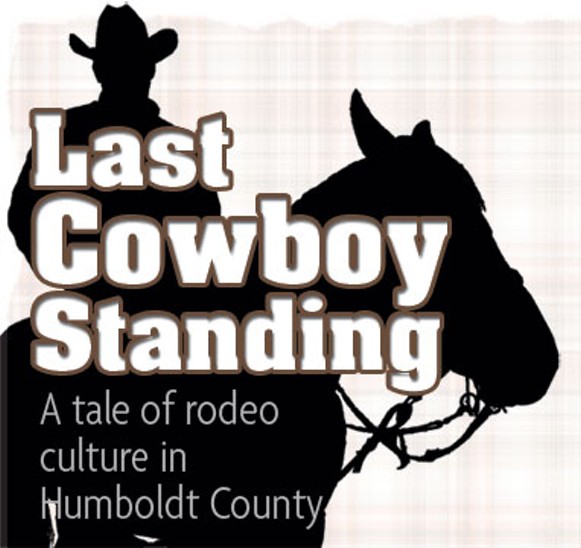
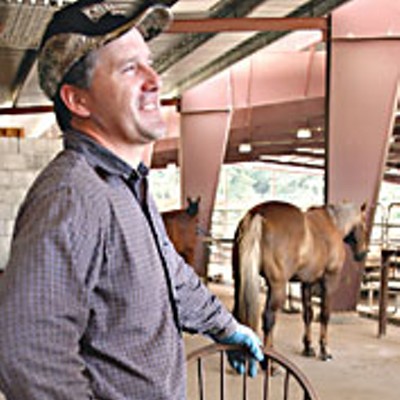
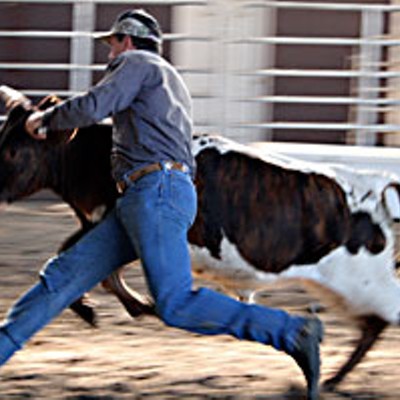
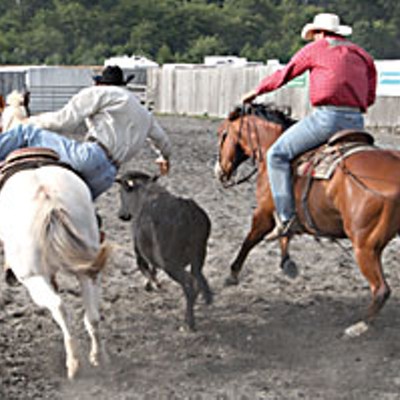

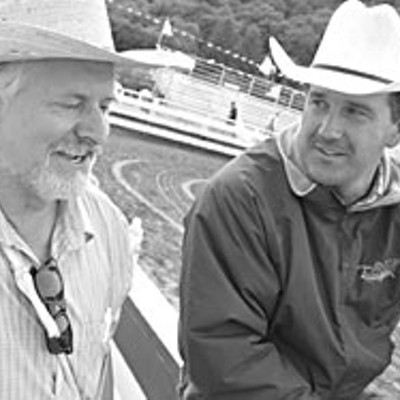

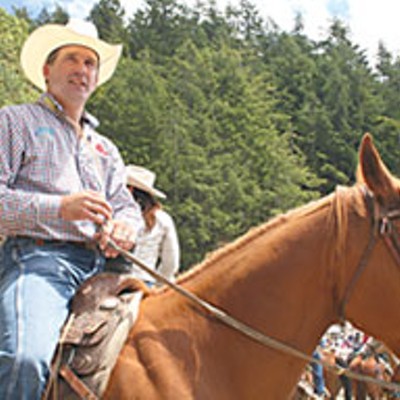

Comments
Showing 1-1 of 1